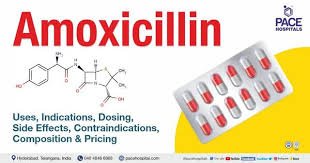
Introduction:
In the vast realm of pharmaceuticals, few medications have had as profound an impact on global health as amoxicillin. This humble antibiotic, belonging to the penicillin group, has saved countless lives since its discovery. Its efficacy, safety, and versatility have made it a cornerstone in the treatment of bacterial infections. Let’s delve into the fascinating story of amoxicillin, its mechanism of action, therapeutic uses, and its ongoing relevance in modern medicine.
A Brief History:
The story of amoxicillin begins with the discovery of penicillin by Alexander Fleming in 1928. However, it wasn’t until the 1970s that researchers developed amoxicillin, a semi-synthetic derivative of penicillin. This modification enhanced its stability and broadened its spectrum of activity against a wider range of bacteria. Since its introduction, amoxicillin has become one of the most prescribed antibiotics globally.
Mechanism of Action:
Amoxicillin exerts its antibacterial effects by inhibiting the synthesis of bacterial cell walls. Specifically, it targets the enzymes responsible for cross-linking the peptidoglycan chains, crucial for the structural integrity of the bacterial cell wall. By disrupting this process, amoxicillin weakens the cell wall, leading to bacterial cell lysis and eventual death.
Therapeutic Uses:
The versatility of amoxicillin is remarkable. It is effective against various bacterial infections, including respiratory tract infections, ear infections, urinary tract infections, skin infections, and certain sexually transmitted diseases like gonorrhea. Moreover, it is often used in combination with other medications to eradicate Helicobacter pylori, a bacterium implicated in peptic ulcers and gastritis.
Pediatric Applications:
Amoxicillin holds a special place in pediatric medicine due to its safety profile and effectiveness in treating common childhood infections such as otitis media and streptococcal pharyngitis. Its palatable formulations, including suspensions and chewable tablets, make it easier for children to take, ensuring compliance with the prescribed regimen.
Challenges and Resistance:
Despite its efficacy, the overuse and misuse of amoxicillin have contributed to the emergence of antibiotic resistance, posing a significant public health challenge. Bacterial strains have developed mechanisms to evade the effects of amoxicillin, rendering it less effective or ineffective. To combat this growing threat, prudent antibiotic stewardship practices and the development of novel treatment strategies are essential.
Side Effects and Precautions:
While generally well-tolerated, amoxicillin can cause adverse effects in some individuals. Common side effects include gastrointestinal disturbances such as nausea, vomiting, diarrhea, and abdominal pain. Allergic reactions, ranging from mild rashes to severe anaphylaxis, can occur, particularly in individuals with a history of penicillin allergy. Patients should always inform their healthcare provider of any known allergies before initiating treatment with amoxicillin.
Pregnancy and Lactation:
Amoxicillin is considered safe for use during pregnancy and lactation when prescribed by a healthcare professional. It is classified as a category B medication by the U.S. Food and Drug Administration (FDA), indicating no evidence of harm to the fetus based on animal studies. However, as with any medication, the potential benefits and risks should be carefully weighed before administration.
Future Directions:
As antibiotic resistance continues to pose a significant threat to public health, ongoing research endeavors aim to develop novel antibiotics or enhance existing ones like amoxicillin. Strategies such as combination therapy, the development of new drug delivery systems, and the exploration of alternative antimicrobial agents offer promising avenues for combating resistant bacterial infections.
Conclusion:
Amoxicillin stands as a testament to the remarkable achievements of modern medicine. From its serendipitous discovery to its widespread use in treating bacterial infections, its impact on global health cannot be overstated. As we navigate the challenges of antibiotic resistance and evolving infectious diseases, amoxicillin remains an invaluable tool in the physician’s arsenal, offering hope and healing to millions around the world.
